
The Gibson L6-S was launched in 1972, and had numerous high profile users and endorsers throughout the mid 1970s. These L6-S endorsers include Carlos Santana, jazz guitarist Al DiMeola, and Rich Williams of Kansas - all of whom appeared in official Gibson publicity with this model.
Other early L6-S users include Keith Richards of the Stones who has been pictured with the L6S Custom, and Paul Stanley of Kiss who had a Midnight Special. Both of these musicians were Gibson endorsers at the time, but were more usually associated with Les Pauls.
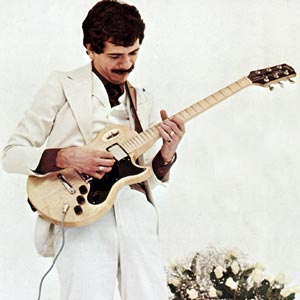
Carlos Santana endorsing the L6-S. From the cover of the 1975 Gibson solid-body catalogue
Carlos Santana started playing the L6-S in 1974 - he heaped praise upon it in the November '74 issue of Guitar Player magazine, and by 1975 was on the cover of the Gibson solid-body catalogue, and further magazine adverts as an endorsee.
“Oh, I just flipped over this Gibson L6-S. It's not like i'm endorsing it, but that axe is beautiful. It's got more accessible frets, and the pickups are just incredible. With the controls, I can make it sound like a Stratocaster, a Telecaster, an SG, or a Les Paul - I get them all. It has a very fast fingerboard, and it's clean sounding.”
Within a couple years Santana was endorsing Yamaha guitars. From June 1978's edition of Guitar Player magazine: “The reason I left Gibson was because I feel like they're McDonalds now; they just wrap a hamburger and throw it at you... Yamaha to me, is more like my wife at Thanksgiving”.
“Yamaha came out with a guitar called a Super Combinator, and the body looks like a takeoff on a Stratocaster, but it's got all those phases that the L6-S has. It sounds like a Telecaster, or like a Strat with the switch between the pickup positions. That's why I liked the L6-S - because it was a Gibson, but it sounded almost like a Strat. But i've got to tell you the truth: that guitar was like a General Motors car - within two months, man, something would always go out. I found myself almost bleeding to sustain a note, and I know it wasn't all the amps fault.”
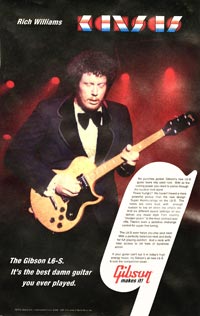
Rich Williams used the L6-S widely in the mid 1970s, and was featured in a 1977 Gibson poster, performing live. Both Williams and Livgren talk about the L6-S in their Guitar Player interview from 1978 (the relevant section is reproduced below).
Rich Williams ..shattered the neck on the Les Paul, and so I thought i'd try something different after that. The Gibson L6-S came out around that time, so I bought a couple of those. One of them was a real piece of crap - it didn't sound any good at all. The other one I liked. The L6-S I played is the first one that ever came to Kansas, and it looked a little different than others i've seen. The inlays on the new ones are round and on mine they were square. I liked it a lot, but I got tired of the maple neck - it seemed to play hard. It's amazing - Kerry's had an ebony neck, and we'd both put on the same kinds of strings on our guitars and his was much easier to play.
Kerry Livgren For some reason stretching strings on a maple neck is really hard.
Guitar Player What is it about the L6-S that you like more than the Les Paul?
Rich Williams I like the variety afforded by the six-way switch, and the pickups have a little bit more groan to them. The bottom seems a little tighter. What I don't like about it is that the six-way switch is a little inconvenient; the standard three-way pickup selector on a Les Paul is a lot easier. The main thing I don't like about the L6-S is that the pickups have so much gain on them - it's really hard to get good crisp tones. Basically my L6-S was stock except that I put Grover 16-to-1 heads on it; I also had the neck worked on and the frets filed down a few times to get rid of buzzes.
Kerry Livgren The thing I like about the L6-S is how high the neck goes; on my Les Paul it's hard to play up around the high A, but on the L6-S it's really easy. It has two full octaves, which means there's two more frets.
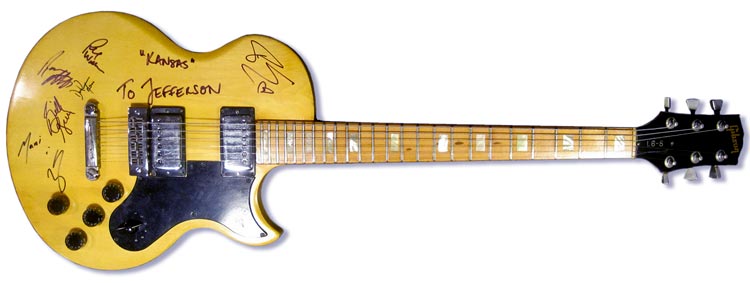
Actually Rich Williams' L6-S - has been modified, probably around 1976. Note the extra control knob where the original output jack was situated. Also the non-polepiece L6-S super-humbuckers have been replaced by what are(perhaps) Gibson PAF style pickups. This guitar was signed by Kansas and gifted to artist Jefferson Wood, who produced some concert artwork for them.
Keith Richards was a Gibson endorsing artist in the middle 1970s, most famously appearing on the cover of the 1975 Les Paul catalogue, but he has been pictured with a natural L6-S, which he received on a visit to the Kalamazoo plant in July 1975.
Jazz guitarist Al DiMeola appeared in this 1977 advertisement for the L6-S playing an ebony Custom.
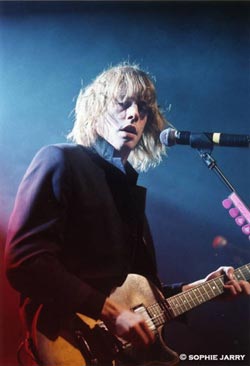
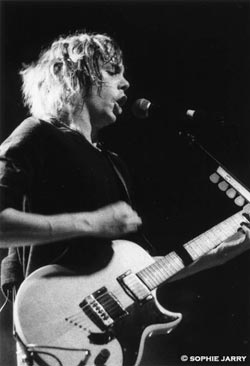
Johnny Borrell of Razorlight plays two L6-S guitars, left: a natural L6-S Deluxe, far left: Tobacco Sunburst L6-S Custom.
“I just got a new guitar! And I got a new amp, so I’ve now got two amps onstage and two guitars exactly the same. And they’re very rare – not expensive, but very rare. It’s a Gibson L6S and they were only made for about five years in the ‘70s, and now I have two of them. So my life is fucking great! Hehehe. I’ve got a Marshall stack, a fucking Vox, and two beautiful guitars. Know what I mean? What more could I want?”
Photos courtesy of photographer Sophie Jarry, quotation from an interview with Johnny Borrell on drowned in sound website
$295
$315
$1750
$1900
$1900
$1995
$2400
$2600
£364
£1690
€2490